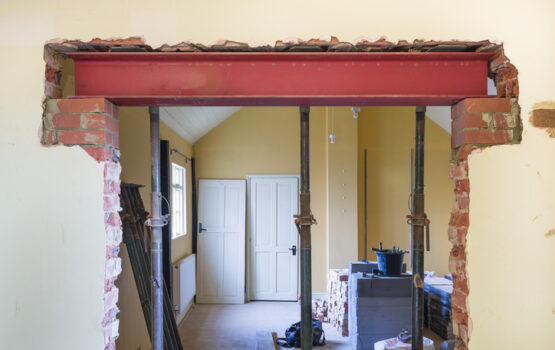What You Should Know About Concrete Spalling & Concrete Cancer
Buildings made out of concrete have many steel bars to ensure reinforcement and stability, which if not carefully maintained can lead to major structural damage. Passivation and pitting are the two main contributors to concrete spalling and cancer, increasing risks, and further destruction.
In this article, you can read about the basics of concrete cancer and spalling, common causes, and how to treat them to prevent your building from danger.
Differences Between Concrete Spalling & Concrete Cancer
At first sight, concrete spalling refers to the state in which concrete begins to break away or degrade, whereas concrete cancer is the propagation of corrosion throughout the concrete matrix.
Concrete spalling can be commonly identified in walls with crumbled, cracked, or flaked concrete, as well as with bubbling or rust stains on the concrete. It can also be spotted by leaks in walls and the roof. It occurs when reinforcing steel is positioned too close to the edge of a concrete slab, or when the concrete is left uncoated and exposed to extreme weathering. On the other hand, concrete cancer refers to the worsening of concrete spalling, in which corrosion is the indicator of said condition.
In essence, concrete spalling can happen when high chloride levels in the environment (very common in coastal areas) cause concrete structures to corrode. Concrete spalling, if left unchecked, can lead to major structural degradation, requiring extensive and costly repairs.
Does My Building Have Concrete Cancer?
Determining if your building has concrete cancer can be done by carefully analysing its status, although it is always recommended to call a special team of Concrete engineers who can provide a deep diagnostic of the condition of your building.
Common signs of concrete cancer include cracking/crumbling concrete, rust stains coming up the concrete or cement render, roof leaks, and bubbling concrete render. Others also include leaks in internal walls and concrete expanding to the outside.
How To Identify Concrete Spalling
To identify concrete spalling, you should pay attention to the concrete surface beginning to crack, rust staining becoming visible on the surface, and the concrete surface beginning to debond and dislodge.
The flaking, chipping, and large chunks that you observe disappearing from your concrete surface, exposing the coarse, rocky concrete aggregate, are signs of spalling concrete. These are the signs, however, spalling concrete is a little more complicated than it appears on the surface.
MJ Engineering Projects can help you identify concrete spalling in your building and provide you with a deep analysis of its condition, recommended course of action, and further information about the status of your edifice. Engaging with a professional Concrete Spalling Repairs Services company that can properly evaluate your environment and help you fix it is essential for ensuring your and others’ safety.
Causes of Concrete Cancer & Concrete Spalling
The causes of concrete cancer and concrete spalling are commonly related to water that gets trapped in the concrete and goes through thaws and freezes, expanding and creating pressure within the slab. Further, the typical sources of both are passivation, pitting, environmental effects, subpar initial construction process, and lack of maintenance.
Below you can take a look at what causes concrete cancer and spalling’s causes for a more in-depth understanding.
Causes of concrete cancer:
- Moisture inside the concrete due to poor waterproofing.
- Chlorides and salt air come in contact with the building (those located near an ocean or river).
- Frequent rain and humidity.
- Building defects.
- Poor-quality concrete.
Concrete cancer is typically found in buildings older than 10 years, but this doesn’t mean that younger edifices shouldn’t be checked to control concrete cancer doesn’t appear.
Causes of concrete spalling:
- The reinforcing bar corroded. In which water gets into the concrete and causes changes and damage to the rebar, as well as internal pressure build-up.
- Frozen and thawed water. When water penetrates concrete, freezes, and then expands again, causing pressure on the material which can cause some parts to start breaking off.
- Alkali silica reaction. This is a type of chemical reaction resulting from reactive silica in the concrete structure (for example, aggregates) and alkaline cement pastes that cause high pressure inside the concrete that tends to swell.
How to Treat Concrete Cancer & Concrete Spalling
There are two common solutions for treating concrete cancer and concrete spalling, which are polymer modified repair and electrochemical treatment.
A polymer modified repair overlay uses a type of concrete in which polymers are used as a binder instead of lime-type cement. They are a cost-effective repair that serves as a great alternative for the disruptive and time-consuming job of breaking out and replacing an old concrete slab. On the other hand, an electrochemical treatment is used to increase alkalinity and/or reduce chloride content in the environment around the reinforcing steel.
Calling a concrete spalling repairs services company is recommended in this case to let a professional team assess the condition of your building and guide you through the repairing process.
The Importance Of Concrete Spalling Repair Services
MJ Engineering Projects provides quality concrete spalling repairs services in Sydney, using the latest technology and updated knowledge on all concrete-related issues your building might be having.
Offering top-class, affordable, and effective solutions for concrete spalling and concrete cancer, MJ Engineering Projects is ready to help you identify the cause of damage and suggest the best course of action that won’t cost you a fortune. Here you can take a look at our concrete spalling repairs services for an in-depth look at our approach.
And if you need to have a professional company assess the condition of your edifice and act as a remedial superintendent on your behalf to act as a mediator between the contractor and you to manage the scope of work, MJ Engineering Projects can help you too. Take a look at our remedial superintendent services and how we can help you.



